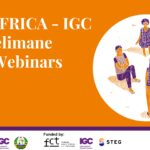Tijan L. Bah
Navarra Center for International Development, University of Navarra,
University of The Gambia e NOVAFRICA
Catia Batista
Nova School of Business and Economics e NOVAFRICA
Flore Gubert
IRD, UMR LEDa-DIAL, PSL, U. Paris-Dauphine, CNRS, Paris School of Economics e NOVAFRICA
David McKenzie
Development Research Group, the World Bank e NOVAFRICA
ISSN 2183-0843
Working Paper No 2203
August 2022
Resumo
Irregular migration from West Africa to Europe across the Sahara and Mediterranean is extremely risky for migrants and a key policy concern. A cluster-randomized experiment with 3,641 young men from 391 settlements in The Gambia is used to test three approaches to reducing risky migration: providing better information and testimonials about the risks of the journey, facilitating migration to a safer destination by providing information and assistance for migration to Dakar, and offering vocational skill training to enhance domestic employment opportunities. Current migration to Senegal was increased by both the Dakar facilitation and vocational training treatments, partially crowding out internal migration. The vocational training treatment reduced intentions to migrate the backway and the number of steps taken toward moving. However, the backway migration rate from The Gambia collapsed, even in the control group, resulting in no space for a treatment effect on irregular migration from any of the three interventions.
Descarregue este Working Paper aqui.
Este Working Paper é um relatório registado e aceite em Journal of Development Economics.







